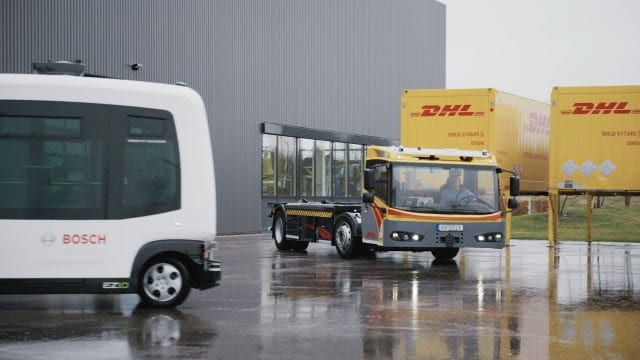Driverless shuttle buses require four separate safety solutions to ensure they operate safely and reliably even in the event of technical failures. So says Bosch, which has led a €4.3 million research initiative to scope out back-up systems to guarantee automated public transport stays on the road.
Bosch said shuttle buses, for carrying passengers around town, should have at least four mechanisms, comprising duplicate safety functions and backup systems, in case their primary power and navigation functions are compromised.
Specifically, they require: a redundant power supply, kept in reserve, so the powertrain and electrical system are protected; additional sensors to create a “3D protection zone”; built-in fault tolerance, so the failure of a subsystem is at least partly compensated for by other functions; and a dynamic response intelligence to react to altered circumstances.
Bosch has tested these functions (detailed below) at a test track at its campus in Renningen, in Baden-Württemberg, as well as at an innovation park near Aachen and in the area around a Deutsche Post/DHL depot. Various pedestrian and traffic scenarios were practised.
The trial, called Project 3F, was funded by the German Federal Ministry of Economic Affairs, and sought ways to ensure low-speed shuttle buses can cope with dynamic road conditions. Bosch was joined on the project by three private companies (Finepower, StreetScooter, RA Consulting), alongside RWTH Aachen University and the FZI Research Center for Information Technology.
Steffen Knoop, project leader in research and advance engineering at Bosch, said: “The solutions developed in the project work not only for driverless shuttle buses. They can also provide robust support for logistics processes.
Project members developed an assistance system for driver-vehicle interaction that enables highly accurate positioning of swap body lifting trucks – special vehicles for moving containers in logistics centres.
“The objective here was to move the vehicles with centimetre precision underneath gantry cranes to enable the swift removal of transport containers. This requires precise localisation and a form of automated parking under the gantry. In practice, this automated maneuver enables error-free container collection and positioning.”
1 | Redundant power
“One solution is to build in redundancy, in other words to duplicate safety-relevant functions. For example, the researchers developed redundant systems for the power supply so that the electrical powertrain and vehicle electrical system are reliably protected.”
2 | Protection zone
“In order to reliably detect obstacles, researchers installed lidar and radar sensors at various points around the vehicle, giving it the ability to observe its surroundings from different positions. By delivering a 360-degree birds-eye view and avoiding blind spots, this creates a kind of 3D protection zone. This setup not only detects obstacles on the road, such as barriers, it also spots things like hanging branches.”
3 | Fault tolerance
“The failure of a subsystem [should be] at least partly compensated by other functions, as with people. If [the shuttle] is blind in a certain area – because, say, leaves are stuck to the sensor or a large object such as a dumpster is blocking the view in one direction – it slows down or omits the parts of the route that can no longer be detected.”
4 | Altered responses
“Shuttle buses [should] also react to altered circumstances. They are programmed to slow down when any moving objects approach or, in case of doubt, to give unknown objects a wide berth. When they identify familiar landmarks such as streetlights, on the other hand, they resume their journey at full speed. If there is any imminent danger, the shuttle will come to a precautionary stop.”

